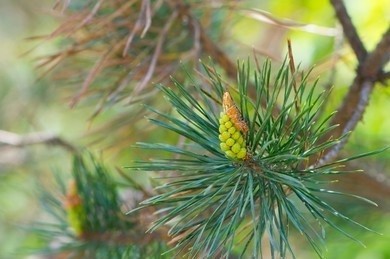Pinus Plant Tissue Culture
 Pinus plant tree growing pine cones
Pinus plant tree growing pine cones
We provide technical services for Pinus plant tissue culture,
which can be used to discover excellent seed sources with high
disease and insect resistance as well as fast-growing and
productive capacity or to rapidly propagate a large number of
transgenic plants with excellent traits.
There are 11 genera in the Pinaceae family, which is the largest extant family of gymnosperms, and Pinus is the largest genus in the Pinaceae family with more than 100 species. Except for a few species distributed south of the equator, all other species of Pinus are distributed in the northern hemisphere.
Pinus species are mostly important reforestation and greening species, and their timber can be used for construction, bridges, and appliances, etc. They are used on a large scale for reforestation of barren mountains, improving the ecological environment, and providing timber for use, fat harvesting, medical treatment, and many other aspects.
Pinus plant contains many chemical components with important biological activities such as sedative, analgesic, antitumor, and antiviral. The seeds of the Pinus plant have high nutritional value and are beneficial to human health for long-term consumption.
Tissue culture service
Since Pinus species are slow-growing, have a long cycle time, and are subject to pests and diseases, Lifeasible offers the service of Pinus plant tissue culture technology, which allows us to propagate Pinus species through tissue culture and achieve large-scale reforestation of good asexual lines. There are three ways of tissue culture of Pinus species, including organogenesis, somatic embryogenesis, and protoplast culture.
Organogenesis
- We have obtained optimal induction results using embryonic explants such as Pinus mature or immature embryos as well as young cotyledons and hypocotyls on sprouting shoots. In addition, seedling tips, needles, and stem segments of mature species can also be used as starting explants.
- Common media we use in Pinus species culture include GD, SH, LP, DCR, GD (modified), etc.
Somatic embryogenesis
- Pinus plant tissue culture by organogenesis is usually tedious and costly because of the amount of meticulous manipulation required. At this point then, somatic embryogenesis may be the more preferable method, both in terms of the number of plantlets produced, cost, and potential genetic gain, and the Pinus seedlings we obtain via somatic embryogenesis are adequate.
- Our most commonly used basic media are DCR, GD, LM, LP, SH, TE, MS, and various modified MS media, modified P6 media and MNCL media are all very effective for somatic embryogenesis of Pinus species.
Protoplast culture
- Based on our extensive experience, young cotyledons, suspension cells, and guardian tissue are suitable materials for isolating Pinus protoplasts. The selection of protoplast media for Pinus plants that we perform is generally based on organogenesis and somatic embryogenesis and commonly used are LP, LM, DCR, and modified Knop or Risser and White media. We usually use liquid shallow cultures and transfer them to solid media after the formation of cell clusters or small healing tissues.
You want to sign a confidentiality agreement.
You have a specific plant species for your experimental needs.
You have a reliable and relevant cooperation project to discuss.
You are very interested in our project or have any questions.
You need an updated and detailed quotation.
For research or industrial use.

 Pinus plant tree growing pine cones
Pinus plant tree growing pine cones
